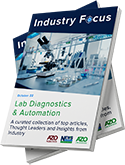In a recent study posted to the medRxiv* preprint server, researchers measured severe acute respiratory syndrome coronavirus-2 (SARS-CoV-2) seroprevalence in industrial livestock operation (ILO) workers of North Carolina, United States (US), between February 2021 and July 2022.

Background
Lab Diagnostics & Automation eBook

North Carolina's ILOs, especially processing facilities, emerged as centers of coronavirus disease 2019 (COVID-19) outbreaks in the spring of 2020. However, confirmed COVID-19 cases underestimated true severe acute respiratory syndrome coronavirus-2 (SARS-CoV-2) seroprevalence. Yet, few studies pursued evidence of COVID-19-related health disparities by socioeconomic status and ethnicity in North Carolina, especially among rural, Black, and Hispanic communities.
Many people from these communities work in animal production, slaughtering, and processing facilities and suffer over 50% more injury and illness than all US workers. Taylor et al. estimated that ~8% of US COVID-19 cases through the summer of 2020 occurred among processing plant and agricultural workers.
North Carolina is the second-largest hog and fourth-largest poultry-producing US state; thus, people working in these facilities, their household members, and nearby communities are more prone to respiratory health problems and infectious diseases. Given the limited access to and availability of reverse transcription-polymerase chain reaction (RT-PCR) testing, SARS-CoV-2 antibody testing could prove an attractive alternative. It could help estimate COVID-19 infection rates, prevalence, and population immunity due to prior infection or vaccination, even among asymptomatic and mild cases. Furthermore, SARS-CoV-2 antibodies are present in saliva, which is easier to collect. Saliva could be readily self-collected at home and mailed to a testing lab.
About the study
In the present study, researchers enrolled 279 individuals from 240 households in collaboration with Rural Empowerment Association for Community Help (REACH), a community group based in Duplin County, North Carolina. They used a multiplex immunoassay to measure their salivary immunoglobulins G (IgG) responses targeting SARS-CoV-2. The team separately measured IgG responses to SARS-CoV-2 nucleocapsid (N), receptor-binding domain (RBD), and spike (S) protein to know whether these responses were antibody- or infection-triggered. At least one adult from ILO group households worked as an industrial hog/poultry operation worker or at an animal rendering or meat packing facility. For comparisons, they also enrolled participants living nearby these facilities but having no occupational exposure to livestock (ILO neighbors or ILON) and participants from metropolitan areas of North Carolina (Metro).
Study findings
The study analysis covered 80 participants in each cohort – ILO, ILON, and Metro. Most participants in all groups were Black Americans. ILON participants were older; ~50% of ILO and ILON and 72.8% of Metro participants were female. Compared to ILO and Metro participants, ILON participants reported not having health insurance (13.3% and 8.7% vs. 15.5%). Likewise, compared to ILO and ILON, more Metro participants had received primary COVID-19 vaccination and at least one booster dose. (13.2% and 10.3% vs. 20.7%).
SARS-CoV-2-induced antibody prevalence among ILO workers and their household members was as high as 63% compared to participants with no household members working at ILO (45.6%). These findings highlight a higher SARS-CoV-2 transmission among meatpacking facility workers and their nearby communities. However, the authors did not observe elevated SARS-CoV-2 infection-induced IgG response in their study population.
The study population comprised barely 23 meatpacking workers but a relatively large number of Black participants in other high-COVID-19-risk jobs. Thus, COVID-19 seroprevalence was comparable between high ILO intensity regions and Metro region residents (42.9% and 48.7%). Also, over time case rates might have converged between these two areas. Intriguingly, although 51% of all study participants had SARS-CoV-2 infection-induced IgG, only 15.4% reported having tested COVID-19-positive. Although testing positive for infection-induced IgG, 68% of participants did not think they had COVID-19, also underlining the importance of accessible RT-PCR testing for COVID-19.
The more-infectious SARS-CoV-2 Delta and Omicron variants spread in the summer and winter of 2021, respectively. Thus, it is also significant that the median date of vaccination completion, including booster doses, was later for ILO compared to ILON and Metro participants. Furthermore, by July 2022, the ILO, ILON, and Metro combined had lower primary COVID-19 vaccination rates (52%) vs. North Carolina (62.9%) and US residents (67.2%). The study results, thus, also highlight the urgent need for dismantling vaccination barriers, especially for ILO workers, their household members, and rural communities.
Living and working in closed, crowded conditions could increase exposure to SARS-CoV-2 from household members and coworkers. Thus, participants with more than one person per household bedroom had a higher prevalence of SARS-CoV-2 infection-induced IgG. Also, it was higher among Hispanic/Latino and Black individuals than White Americans because of their occupational status disadvantages within specific jobs.
Conclusions
The current study results add to reports of high COVID-19 case rates among meatpacking facility workers early in the pandemic by reporting that ILO workers and their families exhibited high rates of SARS-CoV-2 infection-induced IgG. The study results also evidenced health disparities in exposure to SARS-CoV-2 by socioeconomic position.
Indeed, there is an urgent need to vaccinate ILO workers and their families as a priority because they are at a higher risk of contracting COVID-19 compared to the general population and are similarly susceptible as workers in other high-COVID-19-risk occupations (e.g., healthcare workers).
*Important notice
medRxiv publishes preliminary scientific reports that are not peer-reviewed and, therefore, should not be regarded as conclusive, guide clinical practice/health-related behavior, or treated as established information.
- Carolyn Marie Gigot, Nora Pisanic, Kate Kruczynski, Magdielis Gregory Rivera, Kristoffer Spicer, Kathleen M Kurowski, Pranay Randad, Kirsten Koehler, William Clarke, Phyla Holmes, Devon J Hall Jr., Devon Hall, Christopher D Heaney. (2022). SARS-CoV-2 antibody prevalence among industrial livestock operation workers and nearby community residents, North Carolina, USA, 2021-2022. medRxiv. doi: https://doi.org/10.1101/2022.10.31.22281764 https://www.medrxiv.org/content/10.1101/2022.10.31.22281764v1
Posted in: Medical Science News | Medical Research News | Disease/Infection News
Tags: Antibodies, Antibody, Coronavirus, Coronavirus Disease COVID-19, covid-19, Health Disparities, Health Insurance, Healthcare, immunity, Immunoassay, Infectious Diseases, Meat, Omicron, Pandemic, Polymerase, Polymerase Chain Reaction, Protein, Receptor, Respiratory, SARS, SARS-CoV-2, Severe Acute Respiratory, Severe Acute Respiratory Syndrome, Syndrome, Transcription

Written by
Neha Mathur
Neha is a digital marketing professional based in Gurugram, India. She has a Master’s degree from the University of Rajasthan with a specialization in Biotechnology in 2008. She has experience in pre-clinical research as part of her research project in The Department of Toxicology at the prestigious Central Drug Research Institute (CDRI), Lucknow, India. She also holds a certification in C++ programming.
Source: Read Full Article
